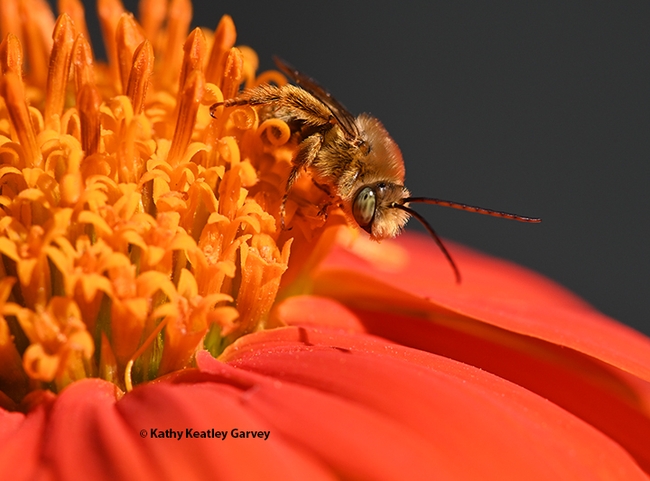Hey, the sun's up! It's time to rise and shine! Maybe I'll shine before I rise...or maybe I'll...
Anyway, I just woke up, and I'm starting to stir. I'm ready to conquer the day. I shall
- Sip nectar
- Seek girlfriend
- Guard the flower patch by dive-bombing and chasing off all critters.
- Repeat.
The scenario: a male longhorned bee, Melissodes agilis, has just spent the night sleeping--and quite cozily at that--on a Mexican sunflower, Tithonia rotundifola.
He is Boy Bee With the Green Mesmerizing Eyes.
Boy Bee With the Green Mesmerizing Eyes does not know--nor would he care if he could--that today is the beginning of National Pollinator Week, an international annual event celebrating pollinator health.
According to the Pollinator Partnership, "pollination is a vital stage in the life cycle of all flowering plants. When pollen is moved within a flower or carried from one flower to another of the same species it leads to fertilization. This transfer of pollen is necessary for healthy and productive native and agricultural ecosystems." It's crucial to our ecosystem.
As the Pollinator Partnership says on its website:
- "About 75 percent of all flowering plant species need the help of animals to move their heavy pollen grains from plant to plant for fertilization."
- "About 1,000 of all pollinators are vertebrates such as birds, bats, and small mammals."
- "Most pollinators (about 200,000 species) are beneficial insects such as flies, beetles, wasps, ants, butterflies, moths, and bees."
But back to Boy Bee With the Mesmerizing Green Eyes.
Noted bee expert, the late Robbin Thorp, a UC Davis distinguished emeritus professor of entomology and co-author of California Bees and Blooms: A Guide for Gardeners and Naturalists (Heyday), used to talk about these little guys bullying all the floral tenants--from honey bees to syrphid flies to butterflies to lady beetles--and more.
Boy, do they move fast. A good time to photograph them is when they're sleeping or just waking up. Otherwise, try to capture images of them at a shutter speed of about 1/5000 of a second.
Happy Beginning of National Pollinator Week!
Attached Images:
